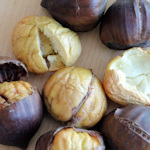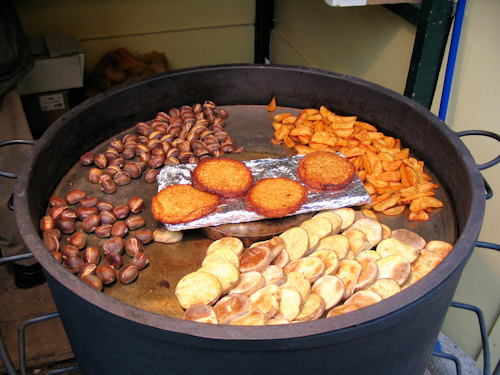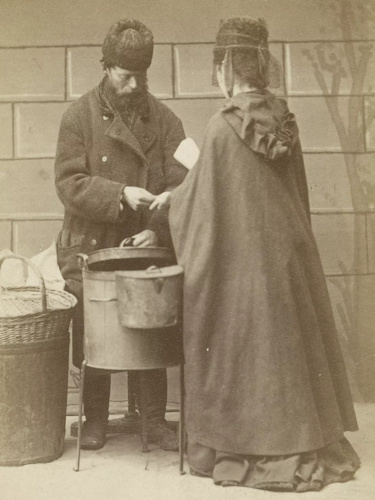
Maroni (roasted chestnuts in their shell) are a popular snack in the Viennese winter, sold on street corners and at markets from the so-called Maronistand.
- A piping-hot and traditional part of any visit to a Christmas market
- Can be bought for home roasting from supermarkets
- See also:
- Weihnachtspunsch (Christmas punch)
- Christmas food
Maroni and friends

(A roasting drum with assorted snacks for sale)
You’ll likely see more than one Maronistand if visiting Vienna during the colder months; these are small one- or two-man stands where they roast chestnuts on an open drum and sell them in packets of 10 or so to passers-by.
Typically, a Maronistand also offers roasted potato slices (German: Bratkartoffel), potato wedges (German: erm…Wedges) and potato puffs (German: Kartoffelpuffer), too. Tornado fries (German: Spiralkartoffeln) have also begun appearing alongside the more traditional choices.
The sizzle and scent of roast chestnuts have become part of the wintry cityscape, evoking memories of simpler times when we all wore fingerless mittens and worried about the potato harvest. Possibly.
The Maronistands tend to pop up around Christmas markets, at major junctions, and outside subway/railway stations. Or at entrances to major attractions like the zoo or Schönbrunn Palace Park.

(The Maronistand is not a new invention. This photo by Leopold Bachrich, published by Johann Knizek, shows a Viennese roast chestnut seller in c. 1877–1878; Wien Museum Inv.-Nr. 72601/7; excerpt reproduced with permission under the terms of the CC0 licence)
Incidentally, the edible nuts come from the sweet chestnut tree, not the horse chestnut, and are usually imported from abroad. Through the winter months you can buy them to roast yourself (see below).
The horse chestnut is a common tree in Vienna, but they’ve suffered considerably in recent years from the horse chestnut leaf miner (Cameraria ohridella), a moth whose larvae cause the leaves to turn brown and drop early. So if you see any sickly-looking chestnut trees, that’s likely to be the reason.
How to roast chestnuts
- Purchase your chestnuts from a reliable source
- Preheat your oven to about 200 degrees centigrade, around 400 Fahrenheit
- Cut a slot in the outer skin of each chestnut. If you leave the nut sealed, the pressure build up can cause them to explode
- Spread the chestnuts out on a tray and bake until cooked through and tender (typically around 20-25 minutes)
- Peel away the skin and check for bad nuts. Chestnuts are a natural product so it’s not unusual to find the occasional rotten one
- The edible part is the soft yellow-whiteish nut inside the brown exterior
One word of warning…when chestnuts come out of the oven or from a Maronistand, they are exceptionally hot.
(Hang around Vienna in winter and you’ll surely spot an innocent visitor or two blowing hurriedly on their fingers after discovering this fact the hard way.)